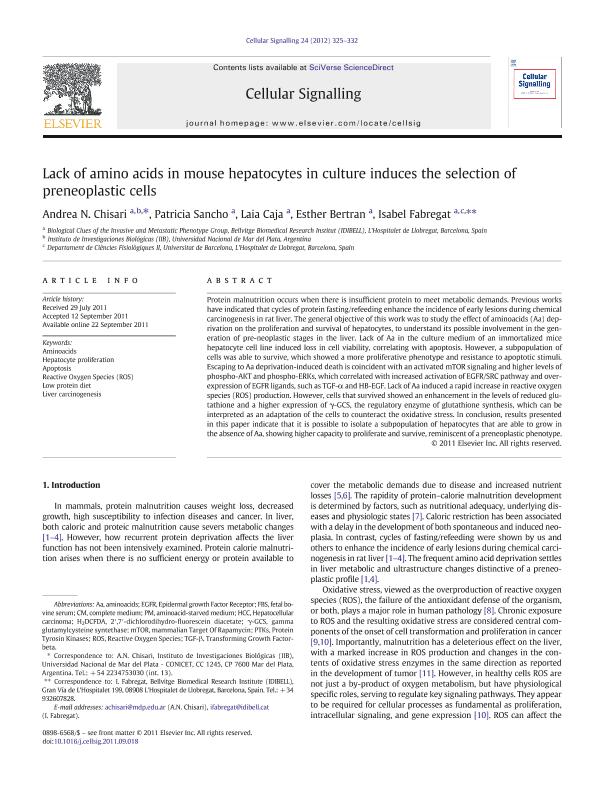Mostrar el registro sencillo del ítem
dc.contributor.author
Chisari, Andrea Nancy

dc.contributor.author
Sancho, Patricia
dc.contributor.author
Caja, Laia
dc.contributor.author
Bertran, Esther
dc.contributor.author
Fabregat, Isabel
dc.date.available
2017-02-15T15:34:20Z
dc.date.issued
2012-01
dc.identifier.citation
Chisari, Andrea Nancy; Sancho, Patricia; Caja, Laia; Bertran, Esther; Fabregat, Isabel; Lack of amino acids in mouse hepatocytes in culture induces the selection of preneoplastic cells; Elsevier Inc; Cellular Signalling; 24; 1; 1-2012; 325-332
dc.identifier.issn
0898-6568
dc.identifier.uri
http://hdl.handle.net/11336/13049
dc.description.abstract
Protein malnutrition occurs when there is insufficient protein to meet metabolic demands. Previous works have indicated that cycles of protein fasting/refeeding enhance the incidence of early lesions during chemical carcinogenesis in rat liver. The general objective of this work was to study the effect of aminoacids (Aa) deprivation on the proliferation and survival of hepatocytes, to understand its possible involvement in the generation of pre-neoplastic stages in the liver. Lack of Aa in the culture medium of an immortalized mice hepatocyte cell line induced loss in cell viability, correlating with apoptosis. However, a subpopulation of cells was able to survive, which showed a more proliferative phenotype and resistance to apoptotic stimuli. Escaping to Aa deprivation-induced death is coincident with an activated mTOR signaling and higher levels of phospho-AKT and phospho-ERKs, which correlated with increased activation of EGFR/SRC pathway and overexpression of EGFR ligands, such as TGF-α and HB-EGF. Lack of Aa induced a rapid increase in reactive oxygen species (ROS) production. However, cells that survived showed an enhancement in the levels of reduced glutathione and a higher expression of γ-GCS, the regulatory enzyme of glutathione synthesis, which can be interpreted as an adaptation of the cells to counteract the oxidative stress. In conclusion, results presented in this paper indicate that it is possible to isolate a subpopulation of hepatocytes that are able to grow in the absence of Aa, showing higher capacity to proliferate and survive, reminiscent of a preneoplastic phenotype.
dc.format
application/pdf
dc.language.iso
eng
dc.publisher
Elsevier Inc

dc.rights
info:eu-repo/semantics/openAccess
dc.rights.uri
https://creativecommons.org/licenses/by-nc-nd/2.5/ar/
dc.subject
Aminoacids
dc.subject
Hepatocyte Proliferation
dc.subject
Apoptosis
dc.subject
Reactive Oxygen Species
dc.subject
Low Protein Diet
dc.subject
Liver Carcinogenesis
dc.subject.classification
Fisiología

dc.subject.classification
Medicina Básica

dc.subject.classification
CIENCIAS MÉDICAS Y DE LA SALUD

dc.title
Lack of amino acids in mouse hepatocytes in culture induces the selection of preneoplastic cells
dc.type
info:eu-repo/semantics/article
dc.type
info:ar-repo/semantics/artículo
dc.type
info:eu-repo/semantics/publishedVersion
dc.date.updated
2017-02-10T18:12:53Z
dc.journal.volume
24
dc.journal.number
1
dc.journal.pagination
325-332
dc.journal.pais
Países Bajos

dc.journal.ciudad
Amsterdam
dc.description.fil
Fil: Chisari, Andrea Nancy. L'Hospitalet de Llobregat; España. Consejo Nacional de Investigaciones Científicas y Técnicas. Centro Científico Tecnológico Mar del Plata. Instituto de Investigaciones Biológicas; Argentina
dc.description.fil
Fil: Sancho, Patricia. L'Hospitalet de Llobregat; España
dc.description.fil
Fil: Caja, Laia. L'Hospitalet de Llobregat; España
dc.description.fil
Fil: Bertran, Esther. L'Hospitalet de Llobregat; España
dc.description.fil
Fil: Fabregat, Isabel. L'Hospitalet de Llobregat; España. Universidad de Barcelona; España
dc.journal.title
Cellular Signalling

dc.relation.alternativeid
info:eu-repo/semantics/altIdentifier/url/http://www.sciencedirect.com/science/article/pii/S0898656811002993
dc.relation.alternativeid
info:eu-repo/semantics/altIdentifier/doi/http://dx.doi.org/10.1016/j.cellsig.2011.09.018
Archivos asociados
